Florida native plants for sustainable landscapes.
Visit PlantRealFlorida.org
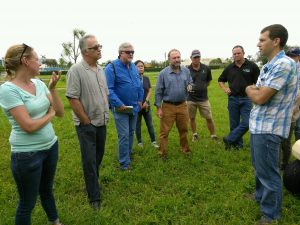
First Annual Texas Phoenix Palm Decline Summit in Fort Lauderdale. About a dozen industry professionals gathered with Dr. Brian Bahder and his team.
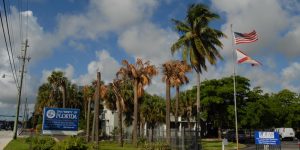
University of Florida IFAS Fort Lauderdale Research and Education Center with diseased Sabal Palms. Photo by UF IFAS.
Summit attendees viewed TPPD firsthand, in various stages of development, on several palms in the research fields at FLREC. UF FLREC has had outbreaks in several locations on their campus, at the front entrance and the pollinator garden. There has also been an outbreak at the school TV station across the street and a block north of them, resulting in the loss of three Canary Island Date Palms. These outbreaks, which started presenting symptoms in late 2014, have given Dr. Bahder and his team, daily firsthand experience with the disease and its progression; and has allowed them to track, test and catalogue the disease frequently and thoroughly.
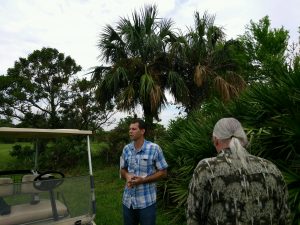
Dr. Brian Bahder with diseased Sabal palms behind him.
BACKGROUND
TPPD, a phytoplasm in the 16SrIV taxonomic group, is a type of very small bacteria that acts like a virus that cannot live independent of its host. This phytoplasm was first described in Texas in 1980, and it was introduced on the west coast of Florida around 2006, with the first report of infection in Hillsborough County. It has since been reported in 28 counties in Florida, particularly the central part of the state with a couple of northern and southern counties also reporting cases. Dr. Bahder sees the distribution of TPPD as useful input to predicting its future tracks.
In 1980, the first hosts recorded were Phoenix palms in Texas, followed shortly by Sabal palmetto. There are currently 10 confirmed susceptible hosts. The host range includes the following palms: Phoenix canarensis – Canary Island Date Palm, Phoenix dactylifera – Edible Date Palm, Phoenix roebellini – Pygmy Date Palm, Phoenix sylvestris – Wild Date Palm (most susceptible), Sabal palmetto – Cabbage Palm, Syagrus romanzoffiana – Queen Palm, Adonidia Merrillii – Christmas Palm, Bismarkia nobilis – Bismark Palm, Livistona chinensis – Chinese Fan Palm, and the Carpentaria acuminate – Carpentaria Palm. Dr. Bahder and his team have also started testing other palms to determine if resistant hosts exist. They will also be testing all palms near outbreaks over time to determine if the disease has spread to new hosts.
WHAT’S THE VECTOR?
We still don’t know for sure. TPPD’s epidemiology is being researched and testing results catalogued. Dr. Bahder has suggested that it could be either an insect, such as Haplaxius crudas, a leaf hopper like insect; or it could be present in an alternative vector host, such as weedy herbaceous plants and grasses growing immediately adjacent to infected plants. Sod, in particular, is a suspected vector host. Sampling and testing is being carried out on both insect and plant vectors using qPCR and High-Resolution Melt Analysis (HRMA) – the two lab tests most recommended for accurate results.
Transmission of TPPD does not come from dead trees. It’s also not likely that TPPD is mechanically transmitted on pruning tools. You can plant another tree in the place where the diseased tree was, as the disease needs a live host to be transmitted.
The spread of TPPD is most apparent alongside roadways and major highways, especially on the west coast of Florida in Hillsborough County. The disease is in palm nurseries and especially obvious and problematic in field nurseries. Possible alternatives for the spread include:
The disease progresses on a time frame similiar to Lethal Yellowing. Some palms show symptoms in as few as four or five months, up to a maximum of four or five years, most likely somewhere in between. Environmental conditions, as well as a palm’s health, size and species, can also help determine the disease progression.
WHAT ARE THE SYMPTOMS?
Though different species show different symptoms, generally, TPPD symptoms are seen first in a general wilting appearance of the palm (early stages); then there is a bronzing or browning of the older lower fronds which moves up to the younger fronds, the inflorescences can be necrotic with the flower sheaths rotted inside, and there can be premature fruit drop (middle stages); and, finally, the spear leaf and crown/canopy will collapse and the palm will die (late stages).
It is sometimes hard to tell the difference between the symptoms of TPPD and Lethal Yellowing. Also, unknown symptom factors such as length of time after infection for symptoms to appear and impact of the environment on symptoms can make it hard to diagnose as well. Wind damage can also look like TPPD.
TESTING FOR TPPD
SENDING SAMPLES TO DR. BAHDER helps UF continue research, narrow down the vector and identify solutions to this lethal disease.
The best way to determine if your palm has TPPD is to take a tissue sample and send it to the UF/FLREC lab for testing. Taking quality samples is important. Generally, the highest amount of phytoplasm will be found in the heart tissue or at the base of the leaf spear. Trunk tissue or leaf tissue can work depending upon how progressed the disease is. It has not been established if the disease is detectable in the roots.
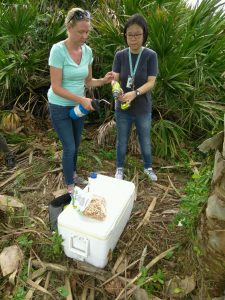
Sterilizing the drill bit before taking core sample from palm. L-R: Biological Scientist Ericka Helmick and PhD student De-Fen Mou.
Sample collecting protocols include:
Contact Dr. Bahder for details on sampling and submission of samples. Testing is time consuming and each sample can take up to two hours to prepare and go through the testing equipment. The qPCR and High-Resolution Melt Analysis (HRMA) are the two tests most recommended for accurate results.
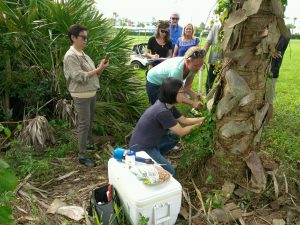
The FLREC Lab Team takes core samples while attendees observe. L-R: lady in sunglasses recording with her phone is Lorelie Agbagala, a Visiting Scholar from the Phillippines assisting with research, squatting in foreground is De-Fen Mou and bending over behind her is Ericka Helmick.
Related articles
University of Florida EDIS article
University of Florida IFAS research announcements
Detection/Diagnosis research by Dr. Bahder
MESSAGE FROM FANN
Sabal Palms have endured thousands of years with little trouble, yet are now threatened by a disease likely imported on non-native palms or other plant material. Our urban landscapes are being homogenized with plants that are not of the place and which bring new problems into our ecosystem. PLANT WHAT BELONGS.
FANN MEMBERS ADVERTISING NATIVE PALMS
Additional FANN member palm suppliers can be found on this website, search by botanical or common name.
Report and most photos by Janine Griffiths, Green Thumb Inc. & Director at Large, FANN Board of Directors